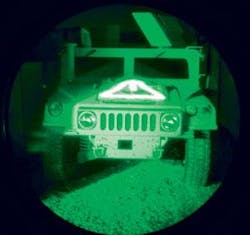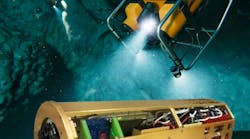By John McHale
WRIGHT-PATTERSON AIR FORCE BASE, Ohio—Engineers at the Air Force Research Laboratory (AFRL) at Wright-Patterson Air Force Base, Ohio, have developed a technology that helps identify friendly forces during combat exercises.
Experts at AFRL’s Materials and Manufacturing Directorate (RX) teamed with engineers at Lumitex Inc. in Strongsville, Ohio, to develop and field the Target Recognition Operator Notification (TRON) system.
“Responding to established needs,” says 1st Lt. T.J. Turner, the lead engineer for Combat Support Technology, “RX partnered with Lumitex to further develop methods established by the Army. Lumitex Inc. produced a fiber-optic cloth that RX researchers realized could be used to develop a more accurate system of identification.”
RX acquired the fiber-optic cloth and worked closely with Lumitex and user groups to create the TRON system and produced 108 prototypes during a period of six months. RX used funds from its Company Grade Officer’s Initiative program, which provides lieutenants and captains the opportunity to receive funding to work on a special project outside its Core Technology Area.
TRON is composed of Lumitex’s thin and flexible fiber-optic woven cloth cut to military specifications. The sheets of the fiber-optic cloth are laminated into layers and can be formed into lighting devices of several shapes and sizes. According to Turner, the woven nature of the cloth emits light in a controlled way creating a uniform light-emitting surface.
AFRL officials say the technology should be inexpensive and rapidly fieldable. It has a long battery life, running 200 hours on two AA batteries, and weighs less than three ounces. The system can be worn under the clothes, on outer tactical vests, on an arm, or mounted to a helmet.
“The TRON I system was first tested at the Team Patriot exercise at Volk Field, Wisconsin,” Turner explains. “Feedback from Army aviation units showed that the system clearly allowed them to identify friendly forces on the ground. Design changes were also suggested by Army and Air Force personnel, which will lead to the future development of TRON. The improved system includes a ruggedized electronics package, modified flash rates, and a new case design.”
After the initial TRON evaluation, Air Force Special Operations Command operators requested that larger units be made to identify friendly positions during close air support operations. This system, known as TRON III, is made of the same fiber-optic cloth but has six times the brightness of TRON I. It hooks into a vehicle’s power supply, so there is no need for an external power supply, AFRL officials say. It is brightly colored for daytime recognition as well.
This prototype was developed as a joint effort between RX officials, who decided on the specifications, and Lumitex engineers, who built the system. TRON III was developed and put in the field for testing three months after the need was established.
“Currently, TRON I and III are being used in deployed locations, and were used at Red Flag, a joint air operation exercise held at Nellis Air Force Base, Nev.,” Turner says. “In real-world conditions, TRON I was used to successfully mark and cordon an unused improvised explosive device, enabling a bomb disposal team to come in and quickly identify and destroy it. It has also been used in over 40 close air support missions. TRON III has been used for at least two successful close air support missions.”
Lumitex recently received a GSA contract, and the TRON I device is now available to government users.




